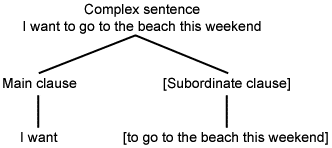Subordination
Subordination is the insertion of a subordinate (dependent) clause into a main clause. In the following example, the subordinate clause is in bold typeface: We won the match even though Frances couldn't play.
Subordinate clauses express additional information about some element of the main clause, and can function as modifiers, adjuncts or complements.
Contents1. Basic facts about subordination 2. Finite versus non-finite subordinate clauses Related pages |
Basic facts about subordination
Subordination involves the combination of a main clause with a subordinate clause. Subordinate clauses express additional information about some element of the main clause, and can function as modifiers, adjuncts or complements. For example, I want to go to the beach this weekend.
Subordinate clauses often (but not always) have a different structure to main clauses and may not be grammatical as independent utterances. For example, *to go to the beach this weekend is not a complete sentence.
Sentences that contain a subordinate clause are called complex sentences. The structure of a complex sentence is given in the diagram below. The subordinate clause is internal to the main clause:

Finite versus non-finite subordinate clauses
One way of distinguishing among subordinate clauses is to identify the type of verb they contain. Verbs in subordinate clauses are either finite or non-finite. Clauses with verbs of each type are associated with different kinds of subordination.
Content clauses are a type of finite subordinate clause. Their subordinate status may be marked by the subordinator that in some environments. The distribution of that in subordinate clauses can be summarised as follows:
If the content clause is in subject position it must be introduced by that.
(That Debbie likes cats is a well established fact.)If the content clause is the complement to a preposition that is not used.
(Mel asked after Debbie said no to a cat.)In other contexts use of the subordinator that varies. It is related to the level of formality and the type of verb involved.
Non-finite subordinate clauses, like to go to the beach this weekend or the bolded clause in Nadine prefers playing tennis are typically complements to the main clause. There are four kinds of non-finite clause. All of them are headed by non-finite verbs of different kinds:
to-infinitival: Sandy hates to wash the cat.
bare infinitival: Sandy helped wash the cat.
gerund-infinitival: Sandy avoids washing the cat.
past-participle: Washed cats are rarely happy cats.
Relative clauses
A relative clause is a finite clause that modifies a noun and is a constituent of the noun phrase which has the noun as its head (for example, the umbrella that I borrowed).
Relative clauses can begin with a relative pronoun (such as which, that or who), a preposition and a relative pronoun (for example, to whom, for which) or no subordinator (for example, the umbrella I borrowed).
To identify a relative clause without a subordinator, we can insert a relative pronoun to see if the sentence still makes sense, for example, the umbrella (that) I borrowed.
Restrictive versus non-restrictive relative clauses
Relative clauses can be used in two functions, either to provide additional defining information or to make parenthetical comments. These two types of relative clauses are not strongly distinguished in spoken Standard Australian English and are not always treated consistently in written Standard Australian English but the distinction can have significant consequences in terms of prosody, punctuation and syntax.
restrictive relative clauses provide central information necessary for correct understanding of the clause. There is no special punctuation associated with this type of relative clause and it is not associated with special prosody. The following sentence contains a restrictive relative clause that provides central information necessary for correct understanding of the clause (because only the friends who make offers of cats are being described):
Friends who offer cats for pets are making some pretty big assumptions.non-restrictive relative clauses contain parenthetical information not necessary for understanding the clause. Non-restrictive relative clauses are often marked by commas (or alternately by dashes or brackets) and are given distinctive prosody. The following sentence contains a non-restrictive relative clause expressing parenthetical information that is not necessary for understanding the clause (because it is a comment about all close friends):
Close friends, who have a lot in common, sometimes still surprise each other,
Fused relatives
In fused relative clauses there is one element that acts both as the head of the NP and as the relativised constituent in the relative clause.
The sentence The person who said that is being hysterical contains a non-fused relative clause.
It can be expressed with the fused relative Whoever said that is being hysterical. Where whoever is the head of the NP and also a part of the relative clause.
The main clause could also be expressed as:
Someone is hysterical.
while the relative clause could be restated as:
Someone said that.
Comparative clauses
Comparative clauses are finite subordinate clauses that are used to compare two different situations. One is encoded in the main clause and the other appears as the subordinate clause.
Comparative clauses typically modify an adverb or an adjective, and are introduced by as or than (for example, The cricket match was longer than we anticipated or Peter played as well as he has ever played).
Comparative clauses introduced by as can also function to modify verb phrases (for example, Rabbit is running as fast as he can).

